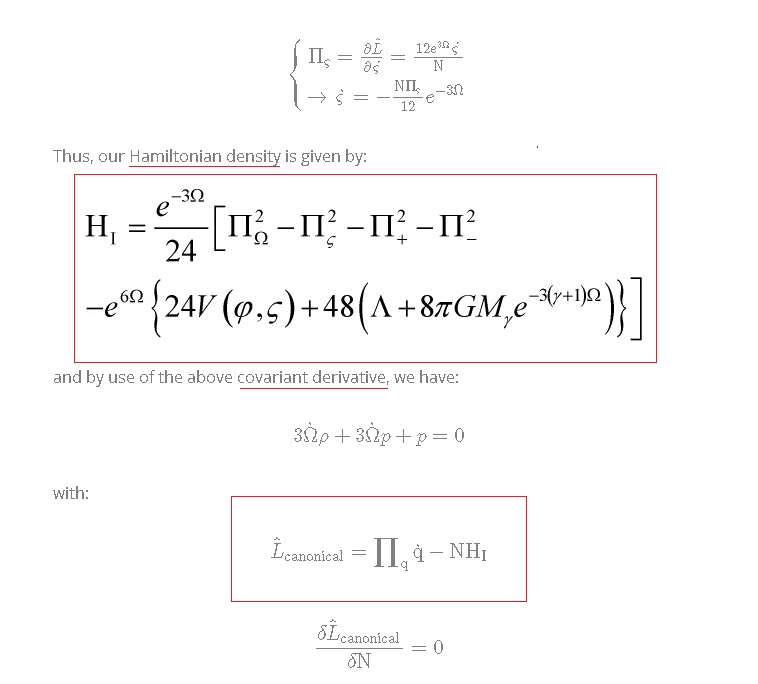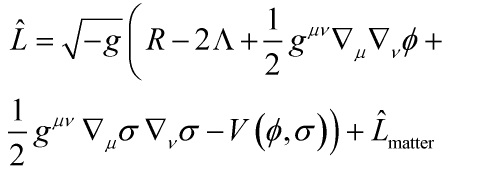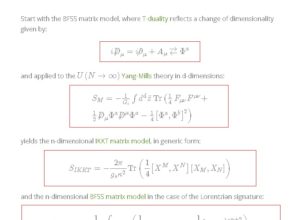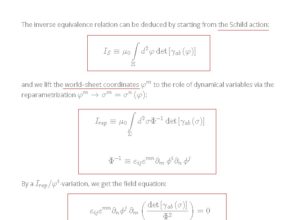Multi-scalar field cosmology is essential for solving the Wheeler-DeWitt equation in the context of quantum gravity. Here, I will test MFI with supersymmetric quantum mechanics based on Witten’s axiomatic approach. One can axiomatize multi-scalar field theory by the following conditions: 1) a Lagrangian containing up to second order derivatives of the fields, and 2) field equations that contain up to second order derivatives of the fields obeying:
with:
![]()
and ![]() symmetric in all of its indices
symmetric in all of its indices ![]()
With the multi-field action in D dimensions having the form:
![]()
whose Euler-Lagrange equations are given by:
![Rendered by QuickLaTeX.com \[\frac{{\partial \hat L}}{{\partial {\pi _i}}} - {\partial _a}\left( {\frac{{\partial \hat L}}{{\partial {\pi _{ia}}}}} \right) + {\partial _a}{\partial _b}\left( {\frac{{\partial \hat L}}{{\partial {\pi _{iab}}}}} \right) = 0\]](https://www.georgeshiber.com/wp-content/ql-cache/quicklatex.com-f0fdff43fa98dda42d9384d3a9a9bbc6_l3.png)
with a fourth derivatives constraint:
![]()
Thus, the universal multi-field action is:
for the multi-fields ![]() , hence the corresponding field equations:
, hence the corresponding field equations:
![Rendered by QuickLaTeX.com \[\begin{array}{l}{G_{\alpha \beta }} + {g_{\alpha \beta }}\Lambda = + \frac{1}{2}\left( {{\nabla _\alpha }\phi {\nabla _\beta }\phi - \frac{1}{2}{g_{\alpha \beta }}{g^{\mu \nu }}{\nabla _\mu }\phi {\nabla _\nu }\phi } \right)\\ + \frac{1}{2}\left( {{\nabla _\alpha }\sigma {\nabla _\beta }\sigma - \frac{1}{2}{g_{\alpha \beta }}{g^{\mu \nu }}{\nabla _\mu }\sigma {\nabla _\nu }\sigma } \right)\\ - \frac{1}{2}{g_{\alpha \beta }}V\left( {\phi ,\sigma } \right) - 8\pi G{{\rm T}_{\alpha \beta }}\end{array}\]](https://www.georgeshiber.com/wp-content/ql-cache/quicklatex.com-4ce0d01a65c2126204734d1167cfb1d6_l3.png)
with:
![Rendered by QuickLaTeX.com \[\begin{array}{c}{g^{\mu \nu }}{\phi _{,\mu \nu }} - {g^{\alpha \beta }}\Gamma _{\alpha \beta }^\nu {\nabla _\nu }\phi - \frac{{\partial V}}{{\partial \phi }} = 0\\ \Leftrightarrow \\{{\hat \bigcirc }_L}\phi - \frac{{\partial V}}{{\partial \phi }} = 0\end{array}\]](https://www.georgeshiber.com/wp-content/ql-cache/quicklatex.com-20259554fd64cc2d1485dc716db7f60b_l3.png)
![Rendered by QuickLaTeX.com \[\begin{array}{c}{g^{\mu \nu }}{\sigma _{,\mu \nu }} - {g^{\alpha \beta }}\Gamma _{\alpha \beta }^\nu {\nabla _\nu }\sigma - \frac{{\partial V}}{{\partial \sigma }} = 0\\ \Leftrightarrow \\{{\hat \bigcirc }_L}\sigma - \frac{{\partial V}}{{\partial \sigma }} = 0\end{array}\]](https://www.georgeshiber.com/wp-content/ql-cache/quicklatex.com-781c68b0cfc738b415847a63f8fc415a_l3.png)
with:
![]()
![]() the energy density,
the energy density, ![]() the pressure, and
the pressure, and ![]() the velocity, satisfying
the velocity, satisfying ![]() .
.
The multi-scalar field cosmological paradigm requires the two canonical fields ![]() , the action of a universe based on such fields, the cosmological term contribution, and matter as a perfect fluid content, and is given by:
, the action of a universe based on such fields, the cosmological term contribution, and matter as a perfect fluid content, and is given by:
Our metric has the form:
![]()
with ![]() a 3 x 3 diagonal matrix,
a 3 x 3 diagonal matrix,
![]()
and ![]() is a scalar and
is a scalar and ![]() are one-forms that characterize each cosmological Bianchi type model, and obey the form:
are one-forms that characterize each cosmological Bianchi type model, and obey the form:
![]()
and ![]() are structure constants of the corresponding model. Hence, in Misner’s parametrization, we get:
are structure constants of the corresponding model. Hence, in Misner’s parametrization, we get:
![]()
with the anisotropic conditions:
![Rendered by QuickLaTeX.com \[\left\{ {\begin{array}{*{20}{c}}{{{\rm{R}}_{\rm{1}}} = {e^{\Omega + {\beta _ + } + \sqrt 3 {\beta _ - }}}}\\{{{\rm{R}}_{\rm{2}}} = {e^{\Omega + {\beta _ + } - \sqrt 3 {\beta _ - }}}}\\{{{\rm{R}}_{\rm{3}}} = {e^{\Omega - 2{\beta _ + }}}}\end{array}} \right.\]](https://www.georgeshiber.com/wp-content/ql-cache/quicklatex.com-d57671853352a0a9d3e72b894f35ad1b_l3.png)
So the lagrangian density above can be written as:
![Rendered by QuickLaTeX.com \[\begin{array}{l}{{\hat L}_{\rm{I}}} = {e^{3\Omega }}\left[ {6\frac{{{{\dot \Omega }^2}}}{{\rm{N}}} - 6\frac{{\dot \beta _ - ^2}}{{\rm{N}}} - 6\frac{{\dot \beta _ - ^2}}{{\rm{N}}} - 6\frac{{{{\dot \varphi }^2}}}{{\rm{N}}} - 6\frac{{{{\dot \varsigma }^2}}}{{\rm{N}}}} \right.\\ + {\rm{N}}\left. {\left( {V\left( {\varphi ,\varsigma } \right) + 2\Lambda + 16\pi G\rho } \right)} \right]\end{array}\]](https://www.georgeshiber.com/wp-content/ql-cache/quicklatex.com-414a20cb5ea5d1083e359ed26288b9c2_l3.png)
with overdot denotes time derivative, with the re-scaling:
![]()
And the momenta are defined as:
![Rendered by QuickLaTeX.com \[\left\{ {\begin{array}{*{20}{c}}{\prod\nolimits_{{q^i}} = \frac{{\partial \hat L}}{{\partial {q^i}}}}\\{{q^i} = \left( {{\beta _ \pm },\Omega ,\varphi ,\varsigma } \right)}\end{array}} \right.\]](https://www.georgeshiber.com/wp-content/ql-cache/quicklatex.com-ba59b796a52cd960c5d3178cf39d64bb_l3.png)
and:
![Rendered by QuickLaTeX.com \[\left\{ {\begin{array}{*{20}{c}}{{\Pi _\Omega } = \frac{{\partial \hat L}}{{\partial \dot \Omega }} = \frac{{12{e^{3\Omega }}\dot \Omega }}{{\rm{N}}}}\\{ \to \dot \Omega = \frac{{{\rm{N}}{\Pi _\Omega }}}{{12}}{e^{ - 3\Omega }}}\end{array}} \right.\]](https://www.georgeshiber.com/wp-content/ql-cache/quicklatex.com-51303a30ada405a76b28c9cd9bcf240c_l3.png)
![Rendered by QuickLaTeX.com \[\left\{ {\begin{array}{*{20}{c}}{{\Pi _ \pm } = \frac{{\partial \hat L}}{{\partial {{\dot \beta }_ \pm }}} = \frac{{12{e^{3\Omega }}{{\dot \beta }_ \pm }}}{{\rm{N}}}}\\{ \to {{\dot \beta }_ \pm } = - \frac{{{\rm{N}}{\Pi _ \pm }}}{{12}}{e^{ - 3\Omega }}}\end{array}} \right.\]](https://www.georgeshiber.com/wp-content/ql-cache/quicklatex.com-1fa70ed588f844c770b25f6084c3c6ff_l3.png)
![Rendered by QuickLaTeX.com \[\left\{ {\begin{array}{*{20}{c}}{{\Pi _\varphi } = \frac{{\partial \hat L}}{{\partial \dot \varphi }} = \frac{{12{e^{3\Omega }}\dot \varphi }}{{\rm{N}}}}\\{ \to \dot \varphi = - \frac{{{\rm{N}}{\Pi _\varphi }}}{{12}}{e^{ - 3\Omega }}}\end{array}} \right.\]](https://www.georgeshiber.com/wp-content/ql-cache/quicklatex.com-c2798e3355fbb1f612b7243adaffd686_l3.png)
![Rendered by QuickLaTeX.com \[\left\{ {\begin{array}{*{20}{c}}{{\Pi _\varsigma } = \frac{{\partial \hat L}}{{\partial \dot \varsigma }} = \frac{{12{e^{3\Omega }}\dot \varsigma }}{{\rm{N}}}}\\{ \to \dot \varsigma = - \frac{{{\rm{N}}{\Pi _\varsigma }}}{{12}}{e^{ - 3\Omega }}}\end{array}} \right.\]](https://www.georgeshiber.com/wp-content/ql-cache/quicklatex.com-0c0f3173b6fff6a81ca2c134157d69a9_l3.png)
Thus, our Hamiltonian density is given by:
and by use of the above covariant derivative, we have:
![]()
with:
![]()
![]()
and:
![]()
and the density solution:
![]()
The Wheeler-DeWitt equation
Hence, our first approximation of the Wheeler-DeWitt equation is:
with:
![]()
the d’Alambertian in the coordinates:
![]()
with the ![]() potential that couples to the wave-function
potential that couples to the wave-function ![]() and gives the whole quantum dynamics by the following equation:
and gives the whole quantum dynamics by the following equation:
![]()
with:
![]()
Using the following ansatz for the wavefunction:
Hence, our Wheeler–DeWitt equation equation is:
with:
![]()
and:
![]()
where ![]() is the superpotential function, and
is the superpotential function, and ![]() is the probability amplitude.
is the probability amplitude.
Let us now utilize the mathematics of supersymmetric quantum mechanics to probe the Wheeler–DeWitt equation and the superpotential via Witten’s formalism of finding the supersymmetric supercharges operators ![]() and
and ![]() that produce a super-Hamiltonian
that produce a super-Hamiltonian ![]() , where the Wheeler–DeWitt equation can be derived as the bosonic sector of this super-Hamiltonian in the superspace. The right method to supersymmetrize a bosonic Lagrangian is to consider the true supersymmetry transformation in the superfield scheme into the bosonic Lagrangian, then the fermionic terms will emerge in a natural way.
, where the Wheeler–DeWitt equation can be derived as the bosonic sector of this super-Hamiltonian in the superspace. The right method to supersymmetrize a bosonic Lagrangian is to consider the true supersymmetry transformation in the superfield scheme into the bosonic Lagrangian, then the fermionic terms will emerge in a natural way.
In this Witten-method, our supercharges for the 3-D case are:
![]()
![]()
where ![]() is defined implicitly by the following equation:
is defined implicitly by the following equation:
![]()
and the super-algebra for the variables ![]() is given by:
is given by:
![Rendered by QuickLaTeX.com \[\left\{ {\begin{array}{*{20}{c}}{\left\{ {{\psi ^\mu },{{\bar \psi }^\nu }} \right\} = {\eta ^{\mu \nu }}}\\{\left\{ {{\psi ^\mu },{\psi ^\nu }} \right\} = 0}\\{\left\{ {{{\bar \psi }^\mu },{{\bar \psi }^\nu }} \right\} = 0}\end{array}} \right.\]](https://www.georgeshiber.com/wp-content/ql-cache/quicklatex.com-0840580d4adf39273573b617ab52e4b7_l3.png)
Under the representation:
![]()
the superspace Hamiltonian takes the form:
![]()
with:
![]()
being the standard Wheeler–DeWitt equation, ![]() the 3-D d’Alambertian in the
the 3-D d’Alambertian in the ![]() coordinates with
coordinates with ![]() , and
, and ![]() and
and ![]() represent the anticommutator and the commutator respectively. The supercharges and the super-Hamiltonian satisfy the following algebra:
represent the anticommutator and the commutator respectively. The supercharges and the super-Hamiltonian satisfy the following algebra:
![]()
Hence, our supersymmetric physical states are selected by the constraints:
![]()
which reduces the problem of finding supersymmetric ground states because the energy is known a priori and the factorization of:
![]()
into
![]()
yields a first-order equation for the ground state wave-function due to the sovability of the bosonic Hamiltonians and normalization just means that supersymmetry is quantum mechanically unbroken.
In the 3-D Grassmannian variable-representation, the wave-function has the following decomposition:
![]()
and with the ansatz:
![]()
introduced into
![]()
and
![]()
where ![]() is the superpotential function obtained as a solution for the Einstein-Hamilton-Jacobi equation, the following identity:
is the superpotential function obtained as a solution for the Einstein-Hamilton-Jacobi equation, the following identity:
![]()
yields the master equation for the auxiliary function ![]() :
:
![]()
with:
![]()
and with the following ansatz:
![]()
we get the second master equation in the form:
![]()
allowing us to get the reduction to:
![]()
and the equations for the functions ![]() are:
are:
![]()
with solutions:
![]()
with ![]() the integration constants.
the integration constants.
To solve our equation:
![]()
we need to write it as a homogeneous linear equation of second degree:
![]()
and we do this by introducing into it the ansatz:
![]()
This way, we obtain a wave-like equation:
![]()
with:
![]()
and:
![]()
The following wave-like ansatz:
![]()
suffices to solve, yielding a condition on the ![]() function:
function:
![]()
where the following conditions hold:
![]()
Allowing us to construct the following term:
![]()
satisfying:
![]()
Now, for:
![]()
we must consider the two cases, one with taking the constant ![]() into account and one without.
into account and one without.
For ![]() and with our superpotential. In this situation,
and with our superpotential. In this situation,
![]()
gives the following equation:
![Rendered by QuickLaTeX.com \[\begin{array}{l}\frac{{{e^{3\Omega }}g{\rm{h}}}}{\mu }\left[ { - 6{{\rm{m}}_0} + 6{{\rm{m}}_1}\frac{{{\eta _1}}}{{{{\rm{b}}_3}}}} \right] - \\2c\left( { - {{\rm{m}}_0}{{\rm{b}}_1} + {{\rm{m}}_1}{{\rm{b}}_2} + {{\rm{m}}_2}{{\rm{b}}_3}} \right) + {\rm{m}}_0^2 - {\rm{m}}_1^2 - {\rm{m}}{2^2} = 0\end{array}\]](https://www.georgeshiber.com/wp-content/ql-cache/quicklatex.com-4bb710ef43b9ec6189c281212738d4ad_l3.png)
with vector solutions:
![]()
For ![]() and with our superpotential. In this situation, we need to separate the following two independent equations:
and with our superpotential. In this situation, we need to separate the following two independent equations:
![]()
where:
![]()
entails that ![]() is a vector of null measure, and:
is a vector of null measure, and:
![]()
entails:
![]()
Now, when we use the superpotential function:
![]()
we get the following structural relations:
![]()
for ![]() , where the constants are:
, where the constants are:
![]()
Hence, supersymmetric quantum mechanics puts the exact constraints on the family of potential fields corresponding to the inflaton exponential Hubble-Fredholm integral.
In the scenario where both equations have no null solution, the solution for the function ![]() has the following structure:
has the following structure:
![]()
thus ![]() and
and ![]() reduce to:
reduce to:
![]()
![]()
Our method above was used to obtain supersymmetric quantum solutions for all cosmological bianchi class A models in Sáez-Ballester theory.
From our superpotential function above, it follows that the only form for ![]() in which our equations are fulfilled, is when the functions
in which our equations are fulfilled, is when the functions ![]() and
and ![]() have exponential behavior. So in a supersymmetric way, the calculation by means of the Grassmannian variables of
have exponential behavior. So in a supersymmetric way, the calculation by means of the Grassmannian variables of ![]() given by:
given by:
![]()
is:
where ![]() is implicitly defined by:
is implicitly defined by:
![]()
with the standard algebra for the Grassmannian numbers ![]() . The integration rules over these numbers are given by:
. The integration rules over these numbers are given by:
![]()
with:
![]()
and we get:
![]()
Thus, Grassmannian integration yields:
![]()
thus supersymmetric quantum mechanics yields the required probability density:
giving us a supersymmetric quantum canonical quantization of the multi-scalar field cosmology of the anisotropic Bianchi type I model and the exact supersymmetric quantum solutions to the Wheeler-DeWitt equation are derived under the ansatz to the wave function:
![]()
which is central for solving the Einstein-Hamilton-Jacobi equation.











